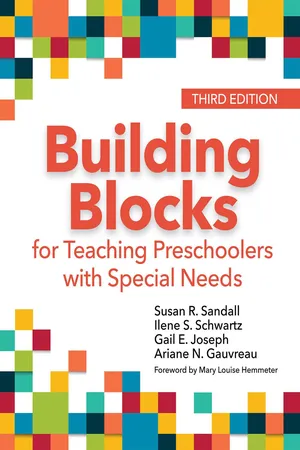
Building Blocks for Teaching Preschoolers with Special Needs
- 240 pages
- English
- ePUB (mobile friendly)
- Available on iOS & Android
Building Blocks for Teaching Preschoolers with Special Needs
About this book
See what's new in the third edition!
Expanded with timely new content and consistent with DEC Recommended Practices, the third edition of this bestselling book will fully prepare a new generation of early childhood educators to teach and include every child. Like the groundbreaking previous editions, this updated Building Blocks guide gives pre? and inservice teachers three types of practical, evidence?based inclusion strategies: curriculum modifications, embedded learning opportunities, and child?focused instructional strategies. Educators will learn how to apply these three strategies for the benefit of all children; review the latest research that supports the Building Blocks model; and find ready?to?use tips and guidance on key topics, such as fostering friendships, encouraging independence, and promoting positive behavior. Reproducible forms help with planning and assessment, and seven comprehensive new training modules make it easy to teach the Building Blocks framework in college courses and professional development sessions.
Equally useful as a student?friendly textbook and a go?to inclusion guide for practicing educators, this is a resource teachers will return to again and again for proven, easy?to?use strategies that support the success of every young learner.
NEW GUIDANCE AND TIPS ON:
- Applying UDL principles to engage every student in your diverse classroom
- Integrating literacy and STEAM into daily activities and routines
- Supporting the executive function skills of all young learners
- Applying new and expanded curriculum modifications
- Collaborating successfully with other team members to ensure the best child outcomes
- Conducting classroom quality assessment
Includes 7 training modules!
- Using the Building Blocks framework
- Conducting ongoing child assessment
- Planning for the individual child
- Using visuals to support learning
- Applying the Building Blocks framework to math and science
- Applying the framework to challenging classroom behavior
- Extending the framework to infants and toddlers
Each module includes a slide deck, presentation notes, learning activities, and a list of other resources and references.
Frequently asked questions
- Essential is ideal for learners and professionals who enjoy exploring a wide range of subjects. Access the Essential Library with 800,000+ trusted titles and best-sellers across business, personal growth, and the humanities. Includes unlimited reading time and Standard Read Aloud voice.
- Complete: Perfect for advanced learners and researchers needing full, unrestricted access. Unlock 1.4M+ books across hundreds of subjects, including academic and specialized titles. The Complete Plan also includes advanced features like Premium Read Aloud and Research Assistant.
Please note we cannot support devices running on iOS 13 and Android 7 or earlier. Learn more about using the app.
Information



Table of contents
- Cover
- Title Page
- Copyright
- Contents
- About the Forms
- About the Professional Development Materials
- About the Authors
- Foreword
- Acknowledgments
- Section I: Using the Building Blocks Framework
- Section II: Teaching Strategies
- Section III: Important Topics Related to the Building Blocks Framework
- References
- Appendix A
- Appendix B: Additional Resources
- Index